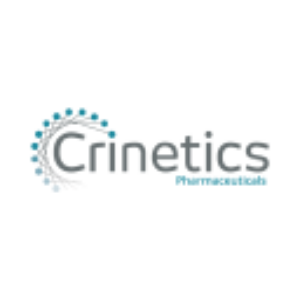Crinetics Announces Positive Topline Results From Phase 2 Trial of Atumelnant in Congenital Adrenal Hyperplasia (CAH)
Rhea-AI Summary
Crinetics Pharmaceuticals (CRNX) announced positive topline results from its Phase 2 trial of atumelnant for Congenital Adrenal Hyperplasia (CAH). The study, involving 28 patients across 3 dose cohorts, demonstrated substantial and statistically significant reductions in key biomarkers, including up to 80% mean reduction of androstenedione.
The trial showed meaningful improvements in CAH symptoms, with notable results including: testosterone normalization in majority of female participants, consistent reduction in total adrenal volume, and resolution of androgen mediated polycythemia in most affected participants. Atumelnant was generally well-tolerated, with no treatment-related severe adverse events or discontinuations.
Based on these positive results, Crinetics plans to proceed with a global Phase 3 pivotal trial for adults and prepare for a Phase 2b/3 trial in pediatric patients this year.
Positive
- Substantial reduction in key biomarkers across all dose levels with statistical significance
- 8 out of 13 female participants showed testosterone normalization
- No treatment-related severe adverse events or trial discontinuations
- Advancement to Phase 3 trials for adults and Phase 2b/3 for pediatric patients
Negative
- Common side effects reported include headache (7/28 patients) and fatigue (5/28 patients)
News Market Reaction 1 Alert
On the day this news was published, CRNX declined 16.31%, reflecting a significant negative market reaction.
Data tracked by StockTitan Argus on the day of publication.
Substantial, Rapid and Sustained Statistically Significant Reductions of Key Biomarkers Achieved Across Doses, Including up to
Meaningful Improvements Demonstrated in Multiple Clinical Signs and Symptoms of CAH Affecting Patient Health
Safety and Efficacy Data Support Initiation of Phase 3 Clinical Trial
Management to Host Investor Conference Call Today at 8:30 AM ET
SAN DIEGO, Jan. 10, 2025 (GLOBE NEWSWIRE) -- Crinetics Pharmaceuticals, Inc. (Nasdaq: CRNX) today announced positive topline results from an open-label, Phase 2 congenital adrenal hyperplasia (CAH) study of investigational atumelnant, a novel, once-daily oral adrenocorticotropic hormone (ACTH) receptor antagonist candidate being developed for the treatment of classic CAH and ACTH-dependent Cushing’s syndrome.
“These exciting results show atumelnant not only lowered key biomarkers, but also had a significant impact on the signs and symptoms of CAH that are important to the overall health of people living with this condition,” said Scott Struthers, Ph.D., founder and chief executive officer of Crinetics. “We are eager to move forward with a global Phase 3 pivotal trial for adults in CAH, as we simultaneously prepare to start a Phase 2b/3 trial in pediatric patients this year. Our internally discovered pipeline now has two drug candidates with positive later stage data, and we look forward to submitting INDs for four additional candidates now in first-in-human enabling studies, as we continue our strategy for building the premier global endocrine company.”
“There has been a long-standing interest in using a potent, selective antagonist of the ACTH receptor for the treatment of CAH and other diseases of ACTH excess, leading to the design of atumelnant by Crinetics scientists,” said Dr. Alan Krasner, M.D., chief endocrinologist of Crinetics. “This Phase 2 study demonstrated that atumelnant was well tolerated and resulted in a reduction of adrenal androgen levels so rapid and robust that it allowed patients to realize meaningful improvements in long-term, pre-existing medical challenges, even within the short 12-week treatment period of this study.”
Highlights from the Phase 2 TouCAHn Trial
The TouCAHn trial is an open-label, global, Phase 2 study designed to evaluate the efficacy, safety, and pharmacokinetics of atumelnant when administered for 12 weeks in people with CAH caused by 21-hydroxylase deficiency. The study enrolled 28 patients across 3 dose cohorts with classic CAH on a stable dose of glucocorticoid replacement.
Primary endpoints included change from baseline in morning serum androstenedione (A4) levels and incidence of treatment-emergent adverse events. Change from baseline in morning serum 17-hydroxyprogesterone (17-OHP) was also evaluated as a secondary endpoint.
Results
For all doses, treatment with atumelnant resulted in rapid, substantial and sustained statistically significant reduction in A4 levels, the key biomarker for disease control (results in chart below).
Primary Endpoint
| Atumelnant, Dosed Once Daily | Mean A4 Baseline* (ng/dL) | A4 Change from Baseline at Week 12 (ng/dL)** |
| 40 mg (n=11) | 1,213 | -619 (p=0.0003) |
| 80 mg (n=11) | 1,231 | -774 (p<0.0001) |
| 120 mg (n=6) | 1,064 | -954 (p<0.0001) |
| *Morning serum levels | **Least square mean change |
Additionally, rapid, substantial and sustained statistically significant reductions in 17-OHP, a confirmatory secondary biomarker of disease control, were achieved across doses. Treatment with atumelnant also had a significant impact on CAH signs and symptoms, including:
- Substantial reduction and normalization of testosterone in the majority of female participants (8/13),1 with 6 of the 11 impacted participants resuming menses
- Consistent reduction in total adrenal volume observed across dose cohorts
- Resolution of androgen mediated polycythemia in 5 of the 6 impacted participants
Atumelnant has been generally well tolerated with no treatment-related severe or serious adverse events to date, irrespective of disease severity or dose level. No participants required dose reduction or discontinued from the trial. All adverse events to-date have been mild to moderate and generally transient. No consistent clinically important trends were observed across key safety parameters, including clinical safety laboratory values, physical examination, electrocardiogram or vital signs. The most common treatment-emergent adverse events included headache (7/28) and fatigue (5/28).
Conference Call and Webcast
Crinetics will host an investor conference call on January 10, 2025, at 8:30 am Eastern Time to discuss the topline results from this study. Following the live event, a replay will be available on the Investors section of the Company’s website.
Dial-in Details:
Domestic: 1-800-445-7795
International: 1-785-424-1699
Conference ID: CRNXQ4
Webcast: https://viavid.webcasts.com/starthere.jsp?ei=1703675&tp_key=d409cb44ff
ABOUT ATUMELNANT
Atumelnant, Crinetics’ second investigational compound, is the first once-daily, oral adrenocorticotropic hormone (ACTH) receptor antagonist that acts selectively at the melanocortin type 2 receptor (MC2R) on the adrenal gland. Diseases associated with excess ACTH can have significant impact on physical and mental health. Atumelnant has exhibited strong binding affinity for MC2R in preclinical models and has demonstrated suppression of adrenally derived glucocorticoids and androgens that are under the control of ACTH. Data from a 12-week Phase 2 study demonstrated compelling treatment benefits of atumelnant, evidenced by the rapid, substantial and sustained statistically significant reductions in key CAH disease related biomarkers, including androstenedione and 17-hydroxyprogesterone, in a diverse population. Atumelnant is currently in development for congenital adrenal hyperplasia and ACTH-dependent Cushing’s syndrome.
For more information about the Phase 2 TouCAHn study in classic CAH, please visit clinicaltrials.gov (NCT05907291).
ABOUT CRINETICS PHARMACEUTICALS
Crinetics Pharmaceuticals is a clinical stage pharmaceutical company focused on the discovery, development, and commercialization of novel therapeutics for endocrine diseases and endocrine-related tumors. Crinetics’ lead development candidate, paltusotine, is the first investigational once-daily, oral, selective somatostatin receptor type 2 (SST2) nonpeptide agonist that is in clinical development for acromegaly and carcinoid syndrome associated with neuroendocrine tumors. Atumelnant is currently in development for congenital adrenal hyperplasia and ACTH-dependent Cushing’s syndrome. All of the company’s drug candidates are orally delivered, small molecule, new chemical entities resulting from in-house drug discovery efforts, including additional discovery programs addressing a variety of endocrine conditions such as hyperparathyroidism, polycystic kidney disease, Graves’ disease (including thyroid eye disease), diabetes, obesity and GPCR-targeted oncology indications.
Forward-Looking Statements
This press release contains forward-looking statements within the meaning of Section 27A of the Securities Act of 1933, as amended, and Section 21E of the Securities Exchange Act of 1934, as amended. All statements other than statements of historical facts contained in this press release are forward-looking statements, including statements regarding the plans and timelines for the clinical development of atumelnant, including the therapeutic potential and clinical benefits or safety profile thereof; the expected timing of additional data and topline results from studies of atumelnant in CAH and ACTH-dependent Cushing’s syndrome; the expected timing and initiation of Phase 3 studies of atumelnant in CAH; the therapeutic potential and clinical benefits or safety profile of paltusotine; and the future development and focus of Crinetics. In some cases, you can identify forward-looking statements by terms such as “may,” “will,” “should,” “expect,” “plan,” “anticipate,” “could,” “intend,” “target,” “project,” “contemplates,” “believes,” “estimates,” “predicts,” “potential,” “upcoming” or “continue” or the negative of these terms or other similar expressions. These forward-looking statements speak only as of the date of this press release and are subject to a number of risks, uncertainties and assumptions, including, without limitation, initial or topline data that we report may change following completion or a more comprehensive review of the data related to the clinical studies and such data may not accurately reflect the complete results of a clinical study, and the FDA and other regulatory authorities may not agree with our interpretation of such results; unexpected adverse side effects or inadequate efficacy of the company’s product candidates that may limit their development, regulatory approval and/or commercialization; clinical studies and preclinical studies may not proceed at the time or in the manner expected, or at all; the timing and outcome of research, development and regulatory review is uncertain, and Crinetics’ drug candidates may not advance in development or be approved for marketing; and the other risks and uncertainties described in the company’s periodic filings with the Securities and Exchange Commission (SEC). The events and circumstances reflected in the company’s forward-looking statements may not be achieved or occur and actual results could differ materially from those projected in the forward-looking statements. Additional information on risks facing Crinetics can be found under the heading “Risk Factors” in Crinetics’ periodic filings with the SEC, including its annual report on Form 10-K for the year ended December 31, 2023 and its Quarterly report on Form 10-Q for the quarter ended March 31, 2024, June 30, 2024, and September 30, 2024. You are cautioned not to place undue reliance on these forward-looking statements, which speak only as of the date hereof. Except as required by applicable law, Crinetics does not plan to publicly update or revise any forward-looking statements contained herein, whether as a result of any new information, future events, changed circumstances or otherwise.
Contact:
Investors:
Gayathri Diwakar
Head of Investor Relations
gdiwakar@crinetics.com
(858) 345-6340
Media:
Natalie Badillo
Head of Corporate Communications
nbadillo@crinetics.com
(858) 345-6075
1 Sample size includes female participants not on hormonal contraceptives with intact uterus. Those with restored menses following atumelnant treatment included three previously amenorrheic participants and three with previously irregular menses.








